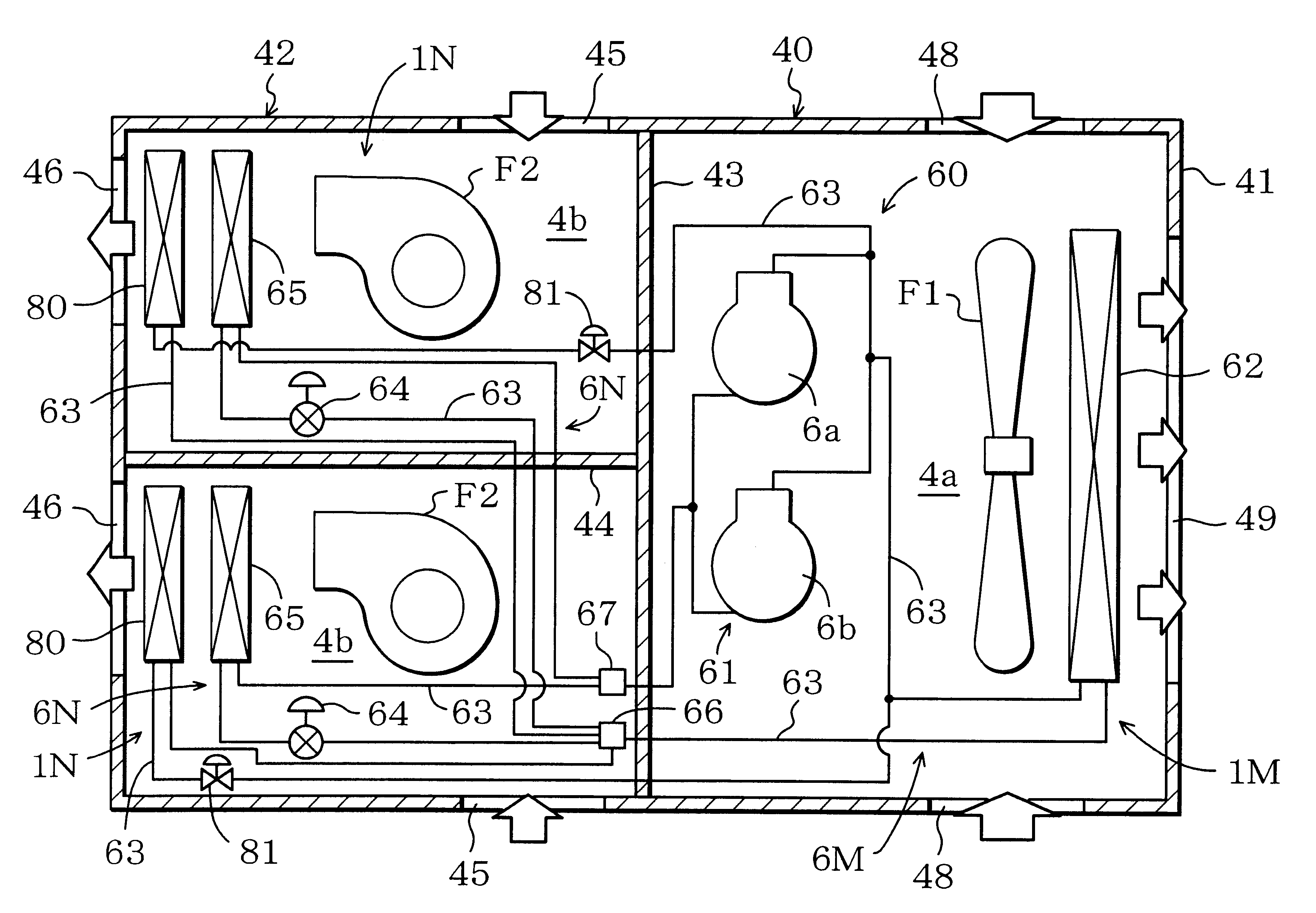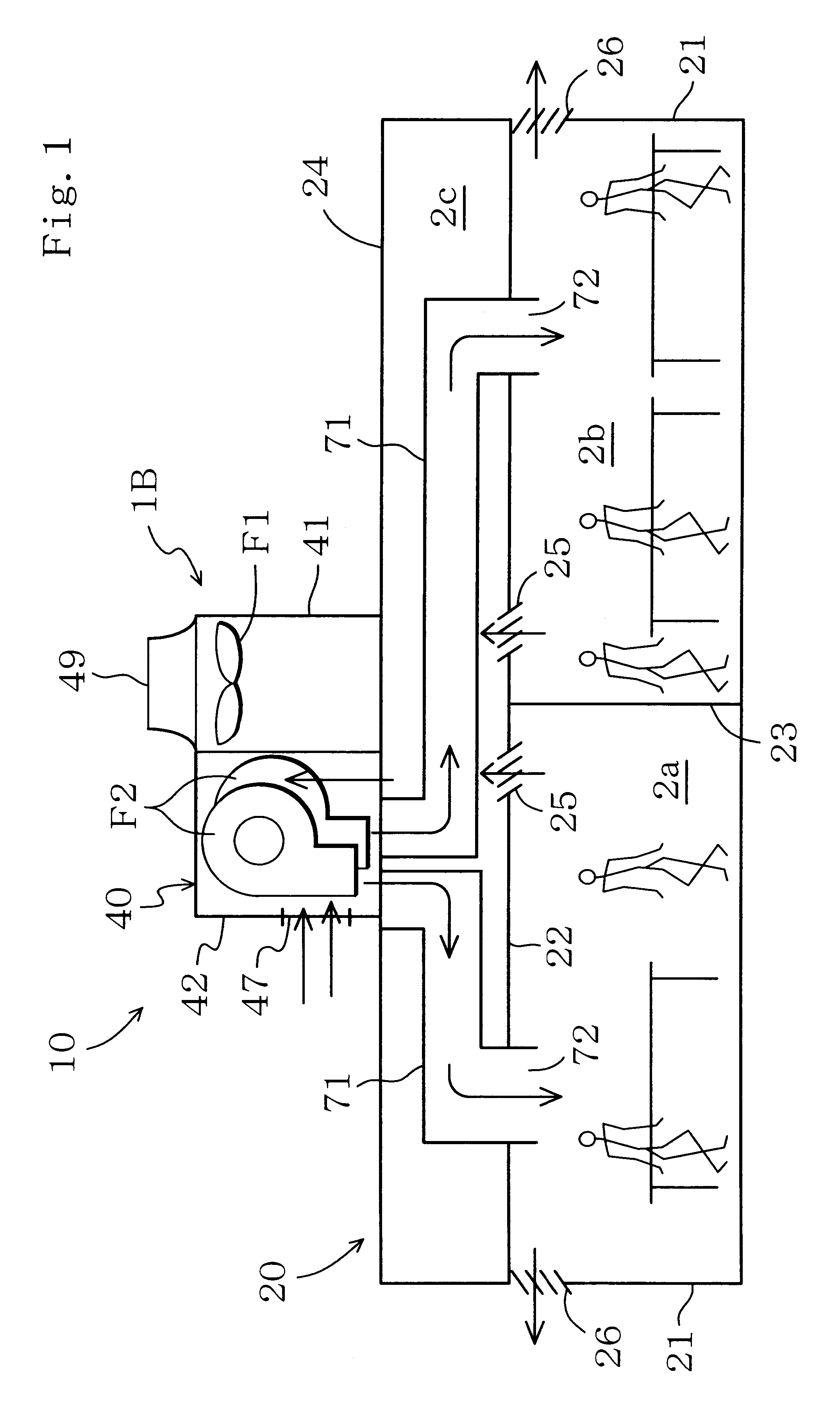Air conditioner
a technology for air conditioners and air conditioners, applied in the field of air conditioners, can solve the problems of deteriorating comfort, difficult individual temperature control of each air conditioning zone, and inability to supply individual air streams to the air conditioning zone,
- Summary
- Abstract
- Description
- Claims
- Application Information
AI Technical Summary
Benefits of technology
Problems solved by technology
Method used
Image
Examples
embodiment 1
Modification of Embodiment 1
The above-mentioned space-heating heat exchanger (11) is a heat exchanger for a space-heating operation only. However, the space-heating heat exchanger (11) may be used as a heat exchanger for a dehumidifying operation, or may be used as a heat exchanger for both space-heating and dehumidifying operations.
Specifically, in a dehumidifying operation, when the refrigerant circuitry (60) is driven, refrigerant is cooled in the heat-use-side heat exchanger (65) to dehumidify room air and outdoor air. Thereafter, the cooled air is heated again in the space-heating heat exchanger (11). This heating of air enables conditioned air having substantially the same temperature as room temperature to be delivered to the respective air conditioning zones (2a, 2b).
As a result, not only room temperature but also room humidity can be controlled. Accordingly, further improved comfortableness can be achieved.
embodiment 2
Next, a detailed description will be given to Embodiment 2 of the present invention with reference to the drawing.
As shown in FIG. 4, in the present embodiment, heat-recycling heat exchangers (80, 80) are provided instead of the space-heating heat exchangers (11, 11) of Embodiment 1.
The heat-recycling heat exchangers (80, 80) are individually provided in the heat-use-side units (1N, 1N) and are individually disposed in the heat-use-side spaces (4b, 4b). One end of the heat-recycling heat exchanger (80) is connected to the discharge side of the compression mechanism (61), with a shut-off valve (81) interposed therebetween, through a piece of the refrigerant piping (63). The other end of the heat-recycling heat exchanger (80) is connected to the branch part (66) through another piece of the refrigerant piping (63).
With this arrangement, in carrying out a dehumidifying operation, the shut-off valves (81, 81) are opened and the compression mechanism (61) is driven. Refrigerant discharge...
embodiment 3
Next, a detailed description will be given to Embodiment 3 of the present invention with reference to the drawing.
As shown in FIG. 5, in the present embodiment, an additional heat exchanger (83) is provided in the refrigerant circuitry (60) of Embodiment 1.
The additional heat exchanger (83) is formed by, for example, a heat exchanger for a kitchen or a heat exchanger in an open-air treatment unit. The refrigerant circuitry (60) is provided with two connection ports (84, 84). The additional heat exchanger (83) is connected to the connection ports (83, 83) through pieces of the refrigerant piping (63, 63).
In the case where the additional heat exchanger (83) is a heat exchanger for a kitchen, refrigerant is heat-exchanged with room air in the kitchen to cool the kitchen. On the other hand, in the case where the additional heat exchanger (83) is a heat exchanger in an open-air treatment unit, the open-air treatment unit is installed in a ventilating opening. The open-air treatment unit ...
PUM
 Login to View More
Login to View More Abstract
Description
Claims
Application Information
 Login to View More
Login to View More - R&D
- Intellectual Property
- Life Sciences
- Materials
- Tech Scout
- Unparalleled Data Quality
- Higher Quality Content
- 60% Fewer Hallucinations
Browse by: Latest US Patents, China's latest patents, Technical Efficacy Thesaurus, Application Domain, Technology Topic, Popular Technical Reports.
© 2025 PatSnap. All rights reserved.Legal|Privacy policy|Modern Slavery Act Transparency Statement|Sitemap|About US| Contact US: help@patsnap.com



